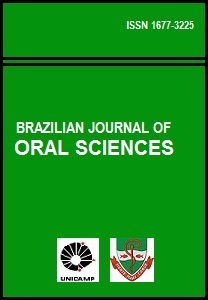Abstract
Aim: To assess which slice inclination would be more accurate in measuring sites for implant placement: the oblique or the orthoradial slice. Methods: Five regions of eight edentulous mandibles were selected (incisor, canine, premolar, first molar and second molar). The mandibles were scanned with a Next Generation i-CAT CBCT unit. Two previously calibrated oral radiologists performed vertical measurements in all the selected regions using both the oblique and orthoradial slices. The mandibles were sectioned in all the evaluated regions in order to obtain the gold standard. The Wilcoxon signed rank test compared the measurements obtained in the oblique and orthoradial slices with the gold standard. Results: The bone height measurements for the first and second molar regions using the orthoradial slices were statistically different from the gold standard. Conclusions: Using the orthoradial slices to obtain cross-sectional images may offer insufficient accuracy for implant placement in the posterior region.
References
Scarfe WC, Farman AG. What is cone-beam CT and how does it work? Dent Clin North Am. 2008; 52: 707-30.
Mozzo P, Procacci C, Tacconi A, Martini PT, Andreis IA. A new volumetric CT machine for dental imaging based on the cone-beam technique: preliminary results. Eur Radiol. 1998; 8: 1558-64.
Arai Y, Tammisalo E, Iwai K, Hashimoto K, Shinoda K. Development of a compact computed tomographic apparatus for dental use. Dentomaxillofac Radiol. 1999; 28: 245-8.
Neves FS, de Almeida SM, Bóscolo FN, Haiter-Neto F, Alves MC, Crusoé-Rebello I. et al. Risk assessment of inferior alveolar neurovascular bundle by multidetector computed tomography in extractions of third molars. Surg Radiol Anat. 2012; 34: 619-24.
Neves FS, Nascimento MC, Oliveira ML, Almeida SM, Bóscolo FN. Comparative analysis of mandibular anatomical variations between panoramic radiography and cone beam computed tomography. Oral Maxillofac Surg. 2013 Aug 24; (in press). .
Lascala CA, Panella J, Marques MM. Analysis of the accuracy of linear measurements obtained by cone beam computed tomography (CBCT-NewTom). Dentomaxillofac Radiol. 2004; 33: 291-4.
Kamburoðlu K, Kiliç C, Ozen T, Yüksel SP. Measurements of mandibular canal region obtained by cone-beam computed tomography: a cadaveric study. Oral Surg Oral Med Oral Pathol Oral Radiol Endod. 2009; 107: e34-42.
Kim TS, Caruso JM, Christensen H, Torabinejad M. A comparison of cone-beam computed tomography and direct measurement in the examination of the mandibular canal and adjacent structures. J Endod. 2010; 36: 1191-4.
Ganguly R, Ruprecht A, Vincent S, Hellstein J, Timmons S, Qian F. Accuracy of linear measurement in the Galileos cone beam computed tomography under simulated clinical conditions. Dentomaxillofac Radiol. 2011; 40: 299-305.
Panmekiate S, Apinhasmit W, Petersson A. Effect of electric potential and current on mandibular linear measurements in cone beam CT. Dentomaxillofac Radiol. 2012; 41: 578-82.
Torres MG, Campos PS, Segundo NP, Navarro M, Crusoé-Rebello I. Accuracy of linear measurements in cone beam computed tomography with different voxel sizes. Implant Dent. 2012; 21: 150-5.
Waltrick KB, Nunes de Abreu Junior MJ, Corrêa M, Zastrow MD, Dutra VD. Accuracy of linear measurements and visibility of the mandibular canal of cone-beam computed tomography images with different voxel sizes: an in vitro study. J Periodontol. 2013; 84: 68-77.
Neves FS, Vasconcelos TV, Campos PS, Haiter-Neto F, Freitas DQ. Influence of scan mode (180°/360°) of the cone beam computed tomography for preoperative dental implant measurements. Clin Oral Implants Res. 2014; 25: 155-8.
Dantas JA, Montebello Filho A, Campos PS. Computed tomography for dental implants: the influence of the gantry angle and mandibular positioning on the bone height and width. Dentomaxillofac Radiol. 2005; 34: 9-15.
Tomasi C, Bressan E, Corazza B, Mazzoleni S, Stellini E, Lith A. Reliability and reproducibility of linear mandible measurements with the use of a cone-beam computed tomography and two object inclinations. Dentomaxillofac Radiol 2011; 40: 244-50.
Sheikhi M, Ghorbanizadeh S, Abdinian M, Goroohi H, Badrian H. Accuracy of linear measurements of Galileos cone beam computed tomography in normal and different head positions. Int J Dent. 2012; 214954. doi: 10.1155/2012/214954.
» https://doi.org/10.1155/2012/214954
Visconti MA, Verner FS, Assis NM, Devito KL. Influence of maxillomandibular positioning in cone beam computed tomography for implant planning. Int J Oral Maxillofac Surg. 2013; 42: 880-6.
Machtei EE, Oettinger-Barak O, Horwitz J. Axial relationship between dental implants and teeth: A radiographic study. J Oral Implantol. 2012 Sep 10. (in press).
Del Fabbro M, Bellini CM, Romeo D, Francetti L. Tilted implants for the rehabilitation of edentulous jaws: a systematic review. Clin Implant Dent Relat Res. 2012; 14: 612-21.
Lindh C, Petersson A, Klinge B. Measurements of distances related to the mandibular canal in radiographs. Clin Oral Implants Res. 1995; 6: 96-103.

This work is licensed under a Creative Commons Attribution 4.0 International License.
Copyright (c) 2013 Brazilian Journal of Oral Sciences

